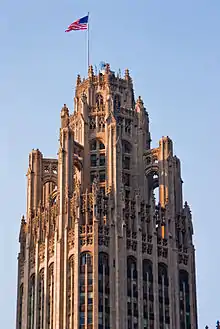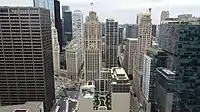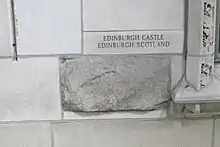| Tribune Tower | |
|---|---|
_(cropped).jpg.webp) Tribune Tower in June 2013 | |
| General information | |
| Type | Office |
| Location | 435 N. Michigan Ave. Chicago, Illinois, USA |
| Coordinates | 41°53′25″N 87°37′25″W / 41.8904°N 87.6237°W |
| Construction started | 1923 |
| Completed | 1925 |
| Height | |
| Antenna spire | 496 feet (151 m) |
| Roof | 463 feet (141 m) |
| Top floor | 428 feet (130 m) |
| Technical details | |
| Floor count | 36 |
| Design and construction | |
| Architect(s) | Howells & Hood—John Mead Howells and Raymond Hood |
| Designated | February 1, 1989 |
The Tribune Tower is a 463-foot-tall (141 m), 36-floor neo-Gothic skyscraper located at 435 North Michigan Avenue in Chicago, Illinois, United States. The early 1920s international design competition for the tower became a historic event in 20th-century architecture.[1] Built for Chicago Tribune owner Robert R. McCormick, since 2018 it has been converted into luxury residences and in 2023 won a Driehaus Prize for architectural preservation and adaptive reuse from Landmarks Illinois.[2]
The tower was the home of the Tribune, and the related Tribune Media, Tribune Broadcasting, and Tribune Publishing. WGN Radio (720 kHz) originated broadcasts from the building until June 18, 2018. CNN's Chicago bureau was also located in the building. It is listed as a Chicago Landmark and is a contributing property to the Michigan–Wacker Historic District. Its predecessor, the first "Tribune Tower", had been built in 1868. It was destroyed in the Great Chicago Fire of 1871.[3]
Design competition
In 1922 the Chicago Tribune hosted an international interior and exterior design competition for its new headquarters to mark its 75th anniversary, and offered $100,000 in prize money with a $50,000 first prize for "the most beautiful and distinctive office building in the world". The competition worked brilliantly for months as a publicity stunt, and the resulting entries still reveal a unique turning point in American architectural history. More than 260 entries were received.
The winner was a neo-Gothic design by New York architects John Mead Howells and Raymond Hood, with buttresses near the top.
The entry that many perceived as the best, by the Finnish architect Eliel Saarinen, took second place and received $20,000. Saarinen's tower was preferred by architects like Louis Sullivan, and was a strong influence on the next generation of skyscrapers, including Raymond Hood's own subsequent work on the McGraw-Hill Building and the Rockefeller Center. The 1929 Gulf Building in Houston, Texas, designed by architects Alfred C. Finn, Kenneth Franzheim, and J. E. R. Carpenter, is a close realization of that Saarinen design. César Pelli's 181 West Madison Street Building in Chicago is also thought to be inspired by Saarinen's design.
Other Tribune tower entries by figures like Walter Gropius, Bertram Goodhue, Walter Burley Griffin, Bruno Taut, and Adolf Loos remain intriguing suggestions of what might have been, but perhaps not as intriguing as the one surmounted by a Mount Rushmore-like head of an American Indian. These entries were originally published by the Tribune Company in 1923 under the title Tribune Tower Competition and later in The Chicago Tribune Tower Competition: Skyscraper Design and Cultural Change in the 1920s by Katherine Solomonson, 2001.
In the 1980 book entitled The Tribune Tower Competition published by Rizzoli, authors Robert A. M. Stern, Stanley Tigerman as well as Bruce Abbey and other architects jokingly submitted "late entries" in Volume II of the work.
Archival materials regarding the competition and the building are held by the Ryerson & Burnham Libraries at the Art Institute of Chicago.
The building
Design
By 1922 the neo-Gothic skyscraper had become an established design tactic, with the first important so-called "American Perpendicular Style" at Cass Gilbert's Woolworth Building of 1913. This was a late example, perhaps the last important example, and criticized for its perceived historicism. Construction on the Tribune Tower was completed in 1925 and reached a height of 462 feet (141 m) above ground. The ornate buttresses surrounding the peak of the tower are especially visible when the tower is lit at night.
As was the case with most of Hood's projects, the sculptures and decorations were made by the American artist Rene Paul Chambellan. The tower features carved images of Robin Hood (Hood) and a howling dog (Howells) near the main entrance to commemorate the architects. The top of the tower is designed after the Tour de beurre (″butter tower″) of the Rouen Cathedral in France,[4] which is characteristic of the Late-Gothic style, that is to say, without a spire but with a crown-shaped top.
Rene Paul Chambellan contributed his sculpture talents to the buildings ornamentation, gargoyles and the Aesops' Screen over the main entrance doors. Rene Chambellan worked on other projects with Raymond Hood including the American Radiator Building and Rockefeller Center in New York City. Also, among the gargoyles on the Tribune Tower is one of a frog. That piece was created by Rene Chambellan to represent himself jokingly as he is of French ancestry.
.jpg.webp) Tribune Tower in 2009
Tribune Tower in 2009 Buttresses on the top of the building
Buttresses on the top of the building.jpg.webp) The Tribune Tower (right) above the Chicago River
The Tribune Tower (right) above the Chicago River Tribune Tower in July 2021, with noticeable additions on part of the condo conversion.
Tribune Tower in July 2021, with noticeable additions on part of the condo conversion.
Collection of famous building fragments

Prior to the building of the Tribune Tower, correspondents for the Chicago Tribune had brought back rocks and bricks from a variety of historically important sites throughout the world at the request of Colonel McCormick. Many of these fragments have been incorporated into the lowest levels of the building and are labeled with their location of origin. Stones included in the wall are from such sites as the St. Stephen's Cathedral, Trondheim Cathedral, Taj Mahal, Clementine Hall, the Parthenon, Hagia Sophia, Süleymaniye Mosque, Corregidor Island, Palace of Westminster, petrified wood from the Redwood National and State Parks, the Great Pyramid, The Alamo, Notre Dame de Paris, Abraham Lincoln's Tomb, the Great Wall of China, Independence Hall, Fort Santiago, Angkor Wat, Ta Prohm, Wawel Castle, Banteay Srei, and Rouen Cathedral's Butter Tower, which inspired the shape of the building.[5][4]
Some of these had a political or social context, such as the stone from the Berlin Wall. The column fragment of Wawel Castle, located in its own niche over the upper-left corner of the main entrance, is a visual tribute to Chicago's large Polish population, the largest such presence outside of the Republic of Poland. There are 149 fragments in the building. In 1999, during a celebration of the 30th anniversary of the Apollo 11 mission, Buzz Aldrin presented a rock brought from the Moon, which was displayed in a window in the Tribune gift store (it could not be added to the wall, as NASA owns a large majority of the Apollo Moon rocks, and this one was merely on loan to the Tribune).[6] The rock was removed in 2011 due to an outdated display.[7] A new rock display is planned but has not been installed as of 2018.[8] A piece of steel recovered from the World Trade Center has been added to the wall.
Buildings influenced by the Tower
Several buildings around the world make reference to the design of the Tribune Tower, most notably in Australia: the spires of the Grace Building in Sydney and the Manchester Unity Building in Melbourne. Additionally, the architects of One Atlantic Center located in the Midtown section of Atlanta were influenced by the building which is most evident in the shaft of the building as well as the base.[9][10]
Freedom Museum
On April 11, 2006, the McCormick Tribune Freedom Museum opened, occupying two stories of the building, including the previous location of high-end gift store Hammacher Schlemmer. The museum closed this location on March 1, 2009, and redirected its efforts to become an online museum.
Open House Chicago
Tribune Tower has participated in Chicago Architecture Foundation's event Open House Chicago every year, starting in 2011. This annual opportunity allows visitors to tour the interior of the building for free.[11][12][13]
Condo conversion
The Chicago Tribune, the building's main tenant since it opened, moved out in June 2018, in order for the building to be converted to condos.[14] The conversion of the building is set to cost more than $500 million.[14] The conversion has run into some legal troubles regarding the sign: the Chicago Tribune contends that the sign is their intellectual property, so it can not remain on the building, but the developers stated that they had a contractual agreement to buy the sign for one dollar.[14] Col. Robert R. McCormick's former iconic office on the 24th floor will be turned into offices.[14] In the former parking lot for Tribune Tower, there are plans to build Tribune Tower East, a super-tall skyscraper that would become the city's second-tallest.
In popular culture
- On November 21 and 28, 2007, in episodes entitled "One Wedding and a Funeral" and "The Thing About Heroes" of the television series CSI: NY, historical pieces stolen from the building led Mac Taylor (Gary Sinise) to his hometown of Chicago. Upon further investigation of the man stalking him, Taylor found a dead body in an office of an unused floor in the building. The episodes were filmed entirely on location in Chicago.
- Conan O'Brien was seen running past the tower while en route from New York to Los Angeles on his first episode as host of The Tonight Show.
- The snipers in Transformers: Dark of the Moon are shooting from the 26th floor of the Tribune Tower just below the buttresses.
See also
References
- ↑ Shaw, Leo (2017-10-03). "How Chicago's Tribune Tower Competition Changed Architecture Forever". Arch Daily. Retrieved 2019-05-22.
- ↑ "Tribune Tower, Chicago". Landmarks Illinois. Retrieved 2024-01-16.
- ↑ "The Driehaus Museum — The Life and Work of Edward J. Burling, Architect". driehausmuseum.org. Retrieved 2017-01-28.
- 1 2 "Tribune Tower - Chicago Tribune". chicagotribune.com. 15 May 2006. Retrieved 2017-01-28.
- ↑ "Tribune Tower rock – Butter Tower – Notre Dame Cathedral – Rouen – France :: Chicago Architecture". chicagoarchitecture.org. Retrieved 2017-01-28.
- ↑ Manier, Jeremy (July 22, 1999). "Sliver of Moon Brightens Michigan Avenue". Chicago Tribune. Chicago, Illinois. p. 197 – via Newspapers.com.
- ↑ "Tribune Tower moon rock gone, but new one to take its place". Chicago Tribune. September 28, 2011. Retrieved September 8, 2019.
- ↑ "How did Tribune Tower get all those stones?". The New Chicagoan. June 5, 2018. Retrieved September 8, 2019.
- ↑ Goldberger, Paul (8 May 1988). "ARCHITECTURE VIEW; American Gothic Rides High in Atlanta's I.B.M. Building". The New York Times.
- ↑ Sams, Gerald W. (1993). AIA Guide to the Architecture of Atlanta. ISBN 9780820314396.
- ↑ "Open House Chicago architectural walking tour - tribunedigital-chicagotribune". Chicago Tribune. 13 October 2011. Retrieved 2017-01-28.
- ↑ "The Immensely Gratifying and Deceptively Short Tribune Tower". Curbed Chicago. 17 October 2012. Retrieved 2017-01-28.
- ↑ "Sites · Open House Chicago". openhousechicago.org. Retrieved 2017-01-28.
- 1 2 3 4 Ori, Blair Kamin and Ryan (17 April 2018). "Developers plan city's second-tallest skyscraper next to new Tribune Tower condos". chicagotribune.com. Retrieved 2021-08-16.
External links
- Chicago Tribune Tower at Structurae
- 1925 – Chicago Tribune Tower, Chicago, Illinois at Archiseek
- Saarinen's second place entry
- "Tribune Tower could be for sale" – Chicago Tribune, June 25, 2008
- Impact of competition entries on skyscraper design
- The Crown at the Tribune Tower
- Howells & Hood restaurant
- Tribune Tower Events
- Tribune Tower at Art Atlas—high-resolution 360° panoramas and images
- Article in Western Architect (1925) with original floor plans